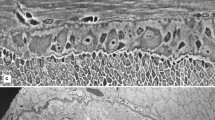Summary
Three types of glial cells corresponding to astrocytes, oligodendrocytes, and microgliacytes were found in the toad spinal cord stained with a modification of the Golgi-Río Hortega technique. Each can be correlated with a characteristic type of nucleus stained with toluidine blue.
Astrocytic neuroglial cells are common near the central canal and have large nuclei with lightly stained nucleoplasm and finely granular chromatin. In silver impregnations, astrocytic neuroglial cells are characterized by many fine, spinose or lamellate excrescences which arise from cell somata and from the long peripherally directed processes that extend to the pia. No cells having the stellate form of mammalian astrocytes were seen, and large end-feet have only been seen near the surface of the brain suggesting that the primary relation of this cell is with the pia rather than with the capillaries.
Oligodendrocytes are common in the white matter and near capillaries, but do not occur as neuronal satellites. Nuclei are characterized by large aggregates of chromatin and deep membrane invaginations. A spectrum of oligodendrocytes has been seen with the Golgi technique similar to the four types described in mammals by del Río Hortega. Small stellate cells of type I and II are most common and are seen in both white and gray matter. Tubular reticulate structures typical of type IV oligodendrocytes are identical to Golgi impregnated Schwann cells of peripheral nerves and are most abundant in the white matter. The absence of an identifiable soma raises the question of whether the reticulum is located on the outer or the inner surface of myelin.
Microgliacytes are most common in areas of dense neuropile and do not form satellites. Nuclei are small, dark, and elongate often with irregular protuberances. In Golgi impregnations two or more long processes arise from a small, irregularly shaped soma. They are covered by spinous or thorn-like processes similar to those of the primitive mammalian pseudopodial variety.
Similar content being viewed by others
References
Achúcarro, N.: De l'évolution de la néuroglie, et spécialement de ses relations avec l'appareil vasculaire. Trab. Inst. Cajal Invest. biol. 13, 169–212 (1915).
Bunge, M. B., R. P. Bunge, and H. Ris: Ultrastructural study of remyelination in adult cat spinal cord. J. biophys. biochem. Cytol. 10, 67–94 (1961).
Charlton, B. T., and E. G. Gray: Comparative electron microscopy of synapses in the vertebrate spinal cord. J. Cell Sci. 1, 67–80 (1966).
de Castro, F.: Algunas observaciones sobre la histogénesis de la neuroglía en el bulbo olfativo. Trab. Inst. Cajal Invest. biol. 18, 83–108 (1920).
del Río Hortega, P.: El “tercer elemento” de los centros nerviosos. I. La microglía en estado normal. II. Intervención de la microglía en los procesos patológicos. III. Naturaleza probable de la microglía. Bol. Soc. esp. Biol. 9, 69–120 (1919).
—: La microglía y su transformación en celulas en bastoncito y cuerpos granuloadiposos. Trab. Inst. Cajal Invest. biol. 18, 37–82 (1920).
—: Estudios sobre la neuroglía. La glía de escasas radiaciones (oligodendroglía). Bol. Real Soc. esp. Hist. nat. 21, 63–92 (1921).
—: Histogénesis y evolución normal; exodo y distribución regional de la microglía. Arch. Histol. (B. Aires) 5, 105–150 (1954). Reprinted from Mem. Real Soc. esp. Hist. nat. 11, 213 (1921).
—: Tercera aportación al conocimiento morfológico e interpretación funcional de la oligodendroglía. Arch. Histol. (B. Aires) 6, 132–183; 239–306 (1956). Reprinted from Mem. Real Soc. esp. Hist. nat. 14, 5–122 (1928).
Gray, P.: The Microtomist's Formulary and Guide. New York: Blakiston 1954.
Herndon, R. M.: The fine structure of the rat cerebellum. II. The stellate neurons, granule cells, and glia. J. Cell Biol. 23, 277–293 (1964).
Herrick, C. J.: The Brain of the Tiger Salamander. Chicago: Chicago University Press 1948.
Katz, B., and R. Miledi: A study of spontaneous miniature potentials in spinal motoneurones. J. Physiol. (Lond.) 168, 389–422 (1963).
Okamoto, M.: Observations on neurons and neuroglia from the area of the reticular formation in tissue culture. Z. Zellforsch. 47, 269–287 (1958).
Penfield, W.: Oligodendroglia and its relation to classical neuroglia. Brain 47, 430–452 (1924).
—: Neuroglia and microglia. The interstitial tissue of the central nervous system, from E. V. Cowdry (ed.), Special Cytology. The form and function of the cell in health and disease, vol. 3, p. 1445–1482. New York: Paul B. Hoeber Inc. 1932.
Peters, A.: The formation and structure of myelin sheaths in the central nervous system. J. biophys. biochem. Cytol. 8, 431–446 (1960).
Ramón y Cajal, S.: Histologie du Système Nerveux de l'Homme et des Vertébrés, vol. 1, Tr. by L. Azoulay. Paris: Maloine 1909.
—: Histology. Revised by J. F. Tello-Múñoz, Tr. from 10th Span. ed. by M. Fernán-Núñez. Baltimore: William Wood & Co. 1933.
Ramón-Molinier, E.: Neuroglia. Transitional forms. J. comp. Neurol. 110, 157–171 (1958).
Rosenbluth, J.: Redundant myelin sheaths and other ultrastructural features of the toad cerebellum. J. Cell Biol. 28, 73–93 (1966).
Serra, M.: Nota sobre las gliofibrillas de la neuroglía de la rana. Trab. Inst. Cajal Invest. biol. 19, 217–230 (1920).
Silver, M. B.: Glial elements of frog. J. comp. Neurol. 77, 41–47 (1942).
Smart, I., and C. P. Leblond: Evidence for division and transformations of neuroglia cells in the mouse brain, as derived from radioautography after injection of thymidine-H3. J. comp. Neurol. 116, 349–367 (1961).
Stensaas, L. J., and S. S. Stensaas: Astrocytic neuroglial cells, oligodendrocytes and microgliacytes in the spinal cord of the toad. II. Electron microscopy Z. Zellforsch. (1968).
Wolff, J.: Elektronenmikroskopische Untersuchungen über Struktur und Gestalt von Astrozytenfortsätzen. Z. Zellforsch. 66, 811–828 (1965).
Author information
Authors and Affiliations
Additional information
We wish to express our gratitude to members of the Department of Ultrastructure for their cooperation. We also wish to thank Dr. Omar Trujillo-Cenóz for his advice and for his review of the manuscript.
Supported by a postdoctoral fellowship from the Cerebral Palsy Research and Educational Foundation.
Rights and permissions
About this article
Cite this article
Stensaas, L.J., Stensaas, S.S. Astrocytic neuroglial cells, oligodendrocytes and microgliacytes in the spinal cord of the toad. Zeitschrift für Zellforschung 84, 473–489 (1967). https://doi.org/10.1007/BF00320863
Received:
Issue Date:
DOI: https://doi.org/10.1007/BF00320863




